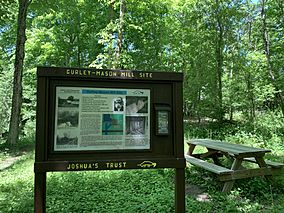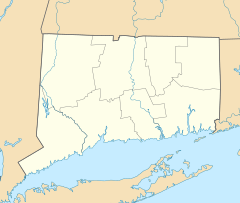Gurley-Mason Mill facts for kids
Quick facts for kids Gurley-Mason Mill |
|
|---|---|
 |
|
| Location | Mansfield, Connecticut |
| Area | 2.31 acres (0.93 ha) |
| Established | 2000 |
| Governing body | Joshua's Trust |
The Gurley-Mason Mill was an old mill in Mansfield, Connecticut. It sat next to the Fenton River. This mill was special because it had both a sawmill (for cutting wood) and a gristmill (for grinding grain).
It was built around 1778 and stopped working around 1935. The mill building was taken down in the 1960s. Today, the land where the mill once stood is a protected area. Joshua's Trust has looked after this 2.31-acre site since 2000. The Gurleyville Historic District is about two miles away, further down the river.
Contents
The Mill's Story
How the Mill Started
The sawmill was built by a person named Zebulon Gurley. This happened no later than 1778. The mill kept running for many years. Different owners took care of it, including Joseph Tinney and John Grant. Later, John Fitch and Jillson Darling also owned it.
The Mason Family Takes Over
In 1864, the Mason family bought the property. They added a gristmill to the site. This meant the mill could now grind grain into flour. Charles and Frank Mason also built a blacksmith shop. This shop was located across the road from the mill.
Frank Mason was in charge of running the mill. Charles Mason made things like chairs, shingles, and sleds. He also built wagons and their parts. Frank Mason passed away in 1928, and Charles in 1929.
The Mill's Final Years
After Charles Mason died, his sons-in-law, Hibbard Parker and Henry Knowlton, ran the sawmill sometimes. They stopped using the mill completely by the mid-1930s. In 1938, a big hurricane hit. It washed away the mill's dam. Charles Mason's grandson, Mason Parker, tried to fix it, but he couldn't. The mill building was taken down in the mid-1960s. The blacksmith shop was removed around 1975.
The Mill Property Today
The Mason family also owned another important place. It was called the Mason-Knowlton Place. This included an old farmhouse and two barns. It is now listed on the Connecticut State Register of Historic Places. The last Mason to own the mill land was Eva Belle Mason Knowlton. She passed away in 1983. In 2000, Leonid and Beth Azaroff gave the mill property to Joshua's Trust.
Why the Mill Was Important
Old-Style Sawing
For over 150 years, the Gurley-Mason Mill used a special kind of saw. It was called an "up-and-down saw." This saw moved up and down to cut wood. Most other mills in the United States switched to "rotary saws" (which spin in a circle) by 1840. But the Mason Mill kept using its old up-and-down saw until it closed around 1935. The Smithsonian Institution even bought the saw and other equipment from the mill.
A Lawsuit About Water
In 1885, Charles Mason and other mill owners went to court. They sued a man named James Hoyle. Hoyle had built a dam on the Fenton River in Willington. This dam reduced the water flow for the mills downstream. The mill owners won the lawsuit. This case is still used today as an example in court. It helps decide cases about riparian water rights. These rights are about who can use water from a river or stream.


